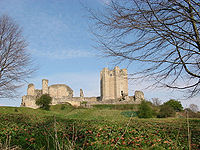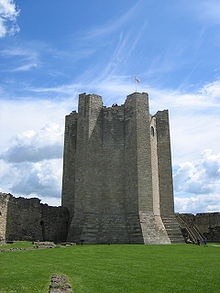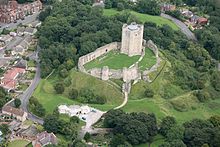- Conisbrough Castle
-
Conisbrough Castle 
Conisbrough Castle, open to the public and property of English HeritageType Castle Proprietor English Heritage Managed by English Heritage as of April 2008 Main feature Castle ruins Other features Events Public access Yes Exhibition Yes Country England Region Yorkshire and the Humber UK Grid square SK5198 Address Conisbrough Castle,
Castle Hill,
Conisbrough,
DONCASTERPostcode DN12 3BU Refreshments Yes Parking Yes Shop Yes Website Website 53°29′03″N 1°13′35″W / 53.48417°N 1.22639°WCoordinates: 53°29′03″N 1°13′35″W / 53.48417°N 1.22639°W Conisbrough Castle is a 12th-century castle in Conisbrough, South Yorkshire, England, whose remains are dominated by the 97-foot (29.5m) high circular keep, which is supported by six buttresses. In the mid-1990s, the keep was restored, with a wooden roof and two floors being rebuilt. Audio and visual displays now help to reconstruct a view of life in a medieval castle, while a history of the site is documented in the adjacent visitors' centre. The building is considered one of South Yorkshire's primary tourist attractions, and sees in excess of 30,000 visitors per year. It is managed by English Heritage, as of 1 April 2008. Doncaster Council own the land the monument is standing on, but English Heritage manages the property.
Contents
History
The castle was probably built by Hamelin Plantagenet on the site of an earlier Norman castle. The Warenne family also owned Sandal Castle near Wakefield, Lewes Castle in Sussex, and Reigate Castle in Surrey, as well as a keep on their lands at Mortemer in Normandy. The Yorkshire lands ceded to The Crown on the death without issue of John de Warenne, 7th Earl of Surrey in 1347.[1]
After Conisbrough reverted to the Crown, Edward III gave it to his youngest son Edmund Langley and was probably during his tenure that the work to improve the accommodation in the inner ward was carried out. Langley died in 1402 and the castle was inherited by his eldest son Edward, 2nd Duke of Albemarle. Albemarle (by then Duke of York) was slain at the Battle of Agincourt in 1415. His widow Maud resided in the castle until her death in 1446 when it passed to Richard, 3rd Duke of York who was killed at the Battle of Wakefield in 1460. His son Edward, Earl of March continued the war emerging victorious and was crowned King Edward IV. Because Edward won the war the castle was not confiscated as would usually have happened when a magnate rebelled against the crown and lost. In this case the castle was inherited by Edward and became Crown property when he ascended to the throne.[1]
By the reign of Henry VIII the castle was in a dilapidated state. In the 1537–38 a survey by Royal Commissioners found that the castle was already a ruin and from the description of the survey most of the damage seen today had already occurred.[1]
It is because it was a ruin by the 17th century, the collapsed gatehouse and parts of the curtain wall made the castle indefensible. This meant that no further damage was done to the fabric of the castle during the English Civil War, that caused so much damage to many old fortifications either through bombardment or slighting, and so, along with sympathetic ownership, the keep survived as a ruin, but largely intact, down to the 21st century.[2]
The name Conisbrough is derived from the Old English Cyningesburh - meaning 'the defended burh of the King', suggesting the area once belonged to one of English kings, prior to the Norman Conquest. At the time of the Norman Conquest the manor of Conisbrough was held by King Harold - he was defeated at the Battle of Hastings.[3][4][5] Earlier documents dated at c. 1000–1004 show lands in this area known as Kyningesburg were granted by Wulfric, one of King Edward's ministers, to Elfhei, another Saxon nobleman.
Conisbrough Castle in fiction
In Sir Walter Scott's novel, Ivanhoe, 'Coningsburgh Castle' is based on Conisbrough. Scott's Coningsburgh is a Saxon fortress, based on the mistaken conclusion by him that its unique style marked its keep as a non-Norman. In the notes that accompany the novel, Scott acknowledges that the outer works were Norman but speculates that the keep—which he describes in some detail in the novel (but which in the notes he says he only viewed hastily)—was similar to Scottish mainland and island Brochs in particular Broch of Mousa in the Shetlands, and hence in Scott's mind, if the castles of the Scottish islands were Scandinavian in origin, then so too could Conisbrough have been a pre-Norman castle built by Scandinavians or Saxons with knowledge of similar Scottish structures.[6] A Victorian romantic vista since shown not to be so.
References
- ^ a b c Pilkington, John. "Castle History". English Heritage. Archived from the original on 2008-04-01. http://web.archive.org/web/20080401170403/http://www.conisbroughcastle.org.uk/History/history.htm. Retrieved 2008-07-01.
- ^ "Conis Castle:History". English Heritage. http://www.conisbroughcastle.org.uk/CastleHistory/CastleHistory.aspx. Retrieved February 2011.
- ^ 'Conquest, Anarchy and Lordship: Yorkshire, 1066-1154' By Paul Dalton, Cambridge University Press, 2002,ISBN 0521524644, 978052152464334, pp. 34
- ^ 'Conisbrough Castle' by Michael Welman Thompson, Great Britain. Dept. of the Environment, H.M.S.O., 1977, ISBN 0116714530, 9780116714534
- ^ 'Ivanhoe' Walter Scott, Sir Walter Scott, Graham Tulloch, Penguin Classics, 2000, ISBN 0140436588, 9780140436587. pp. 481
- ^ Scott, Sir Walter (1836). "Ivanhoe: a romance". Waverley novels. 15-16. Parker. pp. 237, 284–287.
External links
Categories:- Castles in South Yorkshire
- Conisbrough
- Grade I listed buildings in South Yorkshire
- Grade I listed castles
- English Heritage sites in South Yorkshire
- Visitor attractions in Doncaster
- Buildings and structures in Doncaster
- Scheduled Ancient Monuments in South Yorkshire
- Ruins in South Yorkshire
- Historic house museums in South Yorkshire
Wikimedia Foundation. 2010.


